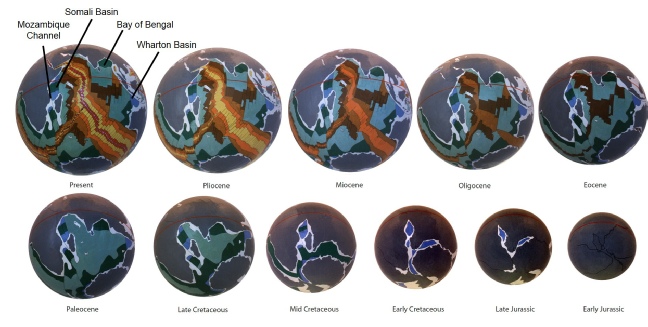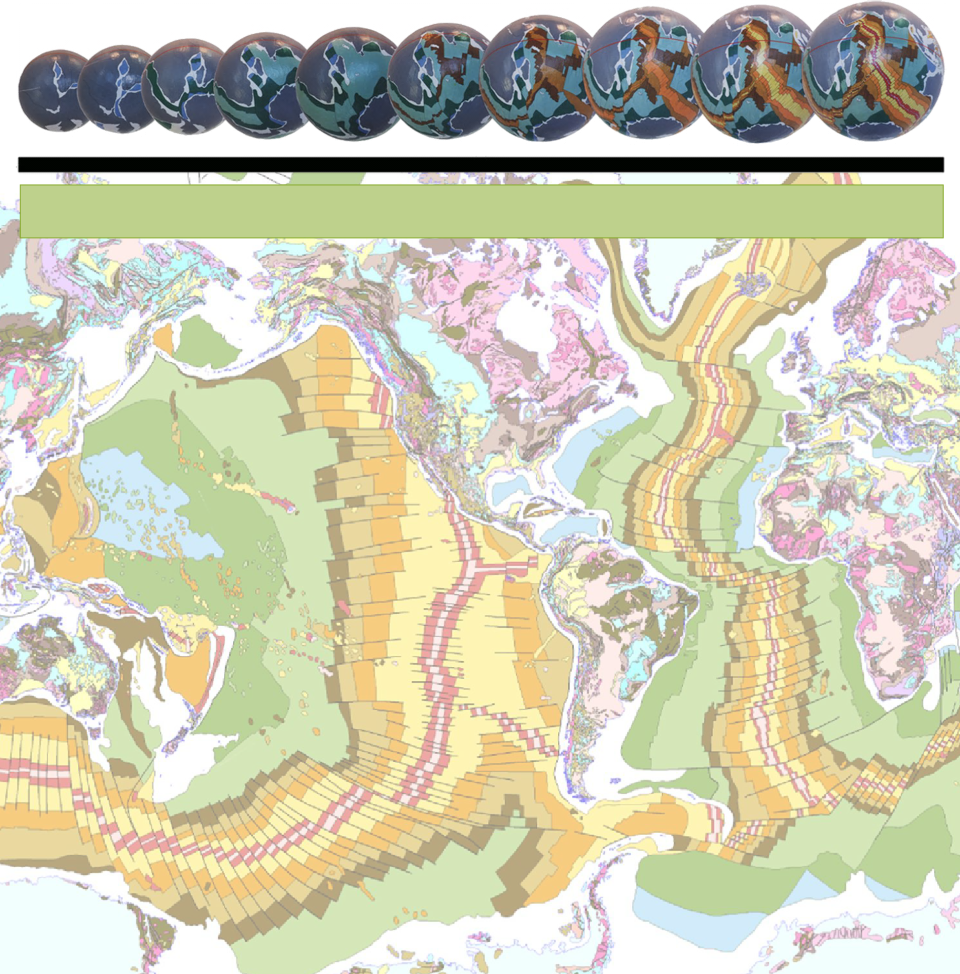INDIAN OCEAN
Reconstructions of the Indian Ocean and assemblage of the surrounding continents is crucial to understanding the conventional assemblage, break-up, and dispersal history of the plate tectonic Gondwana and Pangaea supercontinents. These conventional reconstructions place the precursor to the Indian continent within an ancient southern Gondwana supercontinent, located adjacent to Africa, Madagascar, and Antarctica. The Indian Ocean is then inferred to have formed during the subsequent break-up and dispersal of the Gondwana continental fragments during a later Pangaean supercontinental assemblage cycle.

Indian Ocean Expansion Tectonic small Earth spreading history, extending from the present-day back to the early-Jurassic
In contrast, on an Expansion Tectonic Earth, small Earth modelling shows that the Indian continent remained firmly attached to the Asian continent throughout the Mesozoic and Cenozoic Earth history. The Indian Ocean is then shown to have opened during a post-Triassic phase of crustal rupture of the Pangaea supercontinent, in sympathy with opening of the adjoining Atlantic Ocean basin.
Opening of the Indian Ocean on an Expansion Tectonic Earth commenced during the early-Jurassic Period. This occurred as a result of initial crustal rupturing within two separate areas, located adjacent to both India and Madagascar, in what are now the Somali Basin and the Bay of Bengal. Opening, and a southward extension of the Somali Basin, continued up to the mid-Cretaceous Period which later became the Mozambique Channel located between Madagascar and Africa. During that time the Indian, Madagascan, and Sri Lanka continents and islands continued to remain firmly attached to the ancient Asian continent.
Crustal break-up and opening between Africa, Madagascar, India, and Antarctica then progressively extended south during the early- to late-Jurassic. During that time the Somali Basin and Bay of Bengal areas merged south of Madagascar. The merging of these basins formed what is referred to as a triple-junction—the junction of three separate spreading ridges and crustal plates—south of Madagascar and this region now represents the birthplace of the modern Indian Ocean basin.
The Mozambique Channel represents the northern limb of this early Indian Ocean triple junction. The southern limb of the triple junction extended south, around the tip of South Africa, to form an extension of the South Atlantic Ocean, which opened near the present Falkland Islands. The east limb then extended east to form the emerging Wharton Basin, which lay adjacent to West Australia.
By the mid-Cretaceous Period, the Mozambique Channel spreading ridge was abandoned and a new spreading ridge commenced opening between Madagascar and India. Once abandoned, the Somali Basin, Mozambique Channel, and Madagascar continent then remained as part of the African plate as seafloor crustal extension and opening progressively shifted to the east.
From the mid-Cretaceous to Paleocene times seafloor spreading continued between Madagascar, Africa, and India forming the Arabian Sea. During that time the Indian Ocean underwent a rapid north-south and east-west opening between Australia, Antarctica, Africa, and South East Asia, with a rapid northward opening and displacement of the Indian and Asian continents relative to Antarctica.
During the Paleocene to the present-day, symmetrical seafloor spreading radiated from a new triple junction located within the central Indian Ocean. This new spreading crosscut and displaced the older, previously established Mesozoic seafloor crust. Spreading then extended into the southern Indian Ocean, east between Australia and Antarctica and northeast into the Gulf of Aden. In the southern Indian Ocean region, the southwest limb of this spreading ridge split across older spreading patterns and now forms an extension of the South Atlantic Ocean mid-ocean-ridge system.
The north-south Ninety East spreading ridge, located within the eastern Indian Ocean, was abandoned during the Eocene. A new spreading ridge then extended southeast from the central Indian Ocean triple junction into a newly opening rift zone located between the Australian and Antarctican continental plates. This rifting initiated separation and northward migration of Australia relative to Antarctica, as well as initiation and relatively rapid opening of the Southern Ocean.
As spreading continued, the Gulf of Aden opened during the Miocene along a northwest extension of the central Indian Ocean and Carlsberg spreading ridges. A second triple junction has since formed at the western end of the Gulf of Aden during the Pliocene. This triple junction is now represented by the actively spreading Red Sea ridge and the East African Rift Valley system.


